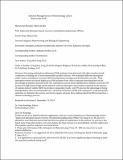| dc.contributor.author | Yang, Yung-Hun | |
| dc.contributor.author | Brigham, Christopher J. | |
| dc.contributor.author | Willis, Laura B. | |
| dc.contributor.author | Rha, ChoKyun | |
| dc.contributor.author | Sinskey, Anthony J. | |
| dc.date.accessioned | 2011-11-03T19:19:21Z | |
| dc.date.available | 2011-11-03T19:19:21Z | |
| dc.date.issued | 2011-01 | |
| dc.identifier.issn | 1573-6776 | |
| dc.identifier.issn | 0141-5492 | |
| dc.identifier.uri | http://hdl.handle.net/1721.1/66917 | |
| dc.description.abstract | Extracting polyhydroxyalkanoate (PHA)
polymer from bacterial cells often involves harsh
conditions, including use of environmentally harmful
solvents. We evaluated different detergents under
various conditions to extract PHA from Ralstonia
eutropha and Escherichia coli cells. Most detergents
tested recovered highly pure PHA polymer from cells
in amounts that depended on the percentage of polymer present in the cell. Detergents such as linear
alkylbenzene sulfonic acid (LAS-99) produced a high
yield of high purity polymer, and less detergent was
needed compared to the amount of SDS to produce
comparable yields. LAS-99 also has the advantage of
being biodegradable and environmentally safe.
Chemical extraction of PHA with detergents could
potentially minimize or eliminate the need to use
harsh organic solvents, thus making industrial PHA
production a cleaner technology process. | en_US |
| dc.description.sponsorship | Malaysian Office of Science, Technology and Innovation | en_US |
| dc.language.iso | en_US | |
| dc.publisher | Springer | en_US |
| dc.relation.isversionof | http://dx.doi.org/10.1007/s10529-010-0513-4 | en_US |
| dc.rights | Creative Commons Attribution-Noncommercial-Share Alike 3.0 | en_US |
| dc.rights.uri | http://creativecommons.org/licenses/by-nc-sa/3.0/ | en_US |
| dc.source | Sinskey | en_US |
| dc.title | Improved Detergent-Based Recovery of Polyhydroxyalkanoates (Phas). | en_US |
| dc.type | Article | en_US |
| dc.identifier.citation | Yang, Yung-Hun et al. “Improved detergent-based recovery of polyhydroxyalkanoates (PHAs).” Biotechnology Letters 33 (2011): 937-942. Web. 3 Nov. 2011. © 2011 Springer | en_US |
| dc.contributor.department | Harvard University--MIT Division of Health Sciences and Technology | en_US |
| dc.contributor.department | Massachusetts Institute of Technology. Department of Biology | en_US |
| dc.contributor.department | Massachusetts Institute of Technology. Engineering Systems Division | en_US |
| dc.contributor.approver | Sinskey, Anthony J. | |
| dc.contributor.mitauthor | Sinskey, Anthony J. | |
| dc.contributor.mitauthor | Brigham, Christopher J. | |
| dc.contributor.mitauthor | Willis, Laura | |
| dc.contributor.mitauthor | Rha, ChoKyun | |
| dc.contributor.mitauthor | Sinskey, Anthony J. | |
| dc.relation.journal | Biotechnology Letters | en_US |
| dc.eprint.version | Author's final manuscript | en_US |
| dc.type.uri | http://purl.org/eprint/type/JournalArticle | en_US |
| eprint.status | http://purl.org/eprint/status/PeerReviewed | en_US |
| dspace.orderedauthors | Yang, Yung-Hun; Brigham, Christopher; Willis, Laura; Rha, ChoKyun; Sinskey, Anthony | en |
| dc.identifier.orcid | https://orcid.org/0000-0002-1015-1270 | |
| dc.identifier.orcid | https://orcid.org/0000-0002-6671-5987 | |
| dspace.mitauthor.error | true | |
| mit.license | OPEN_ACCESS_POLICY | en_US |
| mit.metadata.status | Complete | |
